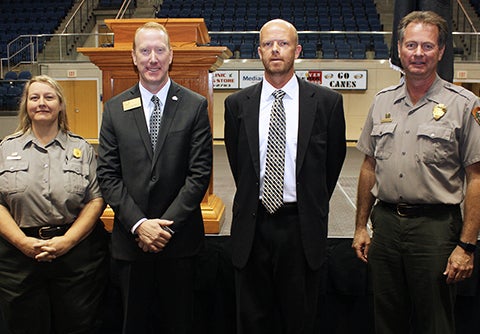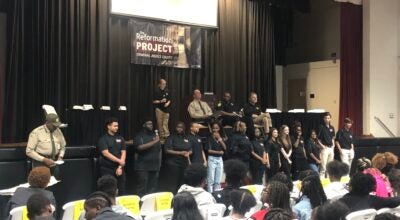Convocation speaker tells of identifying, bringing home American MIAs
Published 1:00 pm Wednesday, September 21, 2016

- From left are Chief of Interpretation at the Andersonville National Historic, Jody Mays; GSW Interim President Charles Patterson; Derek Mallett, Ph.D.; and Charles Sellars, superintendent Andersonville NHS.
By BETH ALSTON
beth.alston@ americustimesrecorder.com
www.americustimesrecorder.com
AMERICUS — The speaker at Wednesday’s POW/MIA Recognition Day convocation in Georgia Southwestern State University’s Storm Dome, can be summed up in one word: fascinating.
Derek R. Mallett, Ph.D., is currently an assistant professor of military history at the U.S. Army Command and General Staff College at Fort Gordon. He spent three years as a research historian for the former Joint Prisoner of War/Missing in Action Accounting Command (JPAC) in Honolulu, Hawaii.
Mallett has 15 years of teaching experience and has taught courses in American history, world history, military history, and Asian civilizations at institutions ranging from high school and community colleges to state universities and the professional military education system. Mallett’s research interests focus on World War II and the early Clold War, as well as prisoner of war studies. His presentation on Wednesday kept the audience of former POWs, the families of those listed as missing in action, and others on the edges of their seats as Mallet spun out one spell-binding story after another.
Mallett’s work with the former JPAC involved highly technical investigative skills. His love of history only added to his expertise.
Mallett began his presentation with a story about working to identify the remains of a B17 crew on a bombing mission in April 1945, in Ronnenberg, Germany. The plane, with its nine-member crew, sustained heavy damages from German fighter planes. It limped along, broke apart and finally crashed in a lake about 30 miles northeast of Berlin. Two crewmembers parachuted out; one was captured, survived the war and came home; one was captured, attempted to escape and was shot and killed. There, five bodies were found floating in the lake, all of which were buried by local Germans. They were exhumed after the war and four were identified. That left one soldier unidentified.
Mallett said this story exemplifies some of the challenges they faced in trying to identify the remains. He said that, among other problems, servicemen of that era often wore clothing that did not belong to them but were labeled with someone else’s name and serial number, and some Marines often swapped dog tags before going into battle.
The one remaining, unidentified body was buried as “known only to God.” Six of the nine crew members were accounted for in addition to one set of unknown remains and three candidates for one set of remains.
“To further complicate things,” Mallet said, there was a second B17 that crashed but was too far away to match any of these remains. One member of that B17 crew had bailed out in the area and could have drifted to the same area the remains were buried in. Three members from one crew and one member from another crew went unidentified.
“That’s where it stood in 1952,” Mallett said. The case sat dormant for decades.
Mallett said that those who work on these projects feel the weight and importance of bringing U.S. service members home.
“The mission is a unique one, even internationally,” he said. “The overall majority of people who work there are totally dedicated to the task.”
Mallett also shared some interesting statistics. He said that, currently, there are 73,121 service members still missing in action (MIA) or unaccounted for from World War II. The Korean War still has 7,804 MIAs. Over 1,600 soldiers from the Vietnam War are still missing. The Cold War is missing 126, and six are still missing from the Iraqi wars. He explained that the U.S. keeps names on the MIA list until remains are located, identified and buried. He said that, in the case of at least half of the World War II missing, officials know where their bodies are but it’s not physically possible to get them. Many of these soldiers’ remains are in places such as sunken ships and planes that crashed over the ocean.
He explained how JPAC accomplishes its mission: with forensic anthropologists and historians. Initially, the historians go on field missions and examine historical documents in an attempt to get an idea of who might have been missing and in what areas.
“Every deceased service member in World War II has a file,” he said. “Some cases are suggested by family members, some by Congress …” He said on one of the field missions they spent three weeks in France, the Netherlands and Belgium, Germany, “literally walking through farmers’ fields … It’s pretty remarkable to be in a field that had been plowed repeatedly yearly since 1945, and find a shell casing from a .45-caliber machine gun from American aircraft, … that’s usually suggestive that human remains will be found.”
He said they also got help from third-party researchers who go into the field and interview witnesses. He mentioned one man who was a member of the USS Honolulu in Dec. 7, 1941, and watched the Japanese bomb Pearl Harbor. This man spent all of his retirement years helping JPAC identify the remains of the missing.
Mallett said that many of these third-party researchers do excellent work and are invaluable, but there are also some third-party researchers attracted to the mission “for the wrong reasons.” He cited a man in Germany who said he found an American P-51 Mustang and had found a bone inside a boot. Upon investigation, Mallett found that the pilot of the plane was not missing, so the bone belonged to someone else. He said the German who had the artifacts has a “bizarre looking bicycle” in his front yard made of the parts he had stripped off the P-51. The man’s basement was also filled with artifacts, Mallett said. The man showed Mallett one particular item which turned out to be the skullcap of a British pilot that he had found.
Mallett told the spellbound audience that there are approximately 8,500 sets of remains from World War II which cannot be identified, and would be buried as unknowns. He said that each set of remains has its own case file containing all the pertinent information such the location of where they were found, the condition of the remains, historic data, and interviews with witnesses, etc. Following intense investigation and paring down to the smallest list possible. Dentists and forensic anthropologists do further investigation and the list is further whittled down. If the remains are exhumed, they go the lab for retrieval of DNA, if possible.
Mallett said that it’s a long but rewarding process.
“The success rate is pretty good once the bodies are exhumed,” he said. “A lot of the cases that were in the offing while I was there are coming to fruition.” Recently, the JPAC received permission to exhume all the unknown remains associated with the USS Oklahoma, which was sunk at Pearl Harbor. He said all those bodies would be exhumed at once.
Mallett said that the nature of the work in actively identifying and bringing home American service personnel is “pretty unique in the world.” He said the Netherlands has a “pretty comprehensive effort” and that the Germans have stepped up their efforts in the last decade or two after the reunification of Germany.
“The British have always had a fairly comprehensive effort,” he said, although they don’t have the same interest in actively identifying bodies, but to simply account for them and move on, Mallett related a story about this tendency of the British.
Near the end of World War II there was an American who had parachuted out of his plane and, when he landed, he met up with 31 British special air assault commandoes. All 32 ended up together in France, where they were eventually ambushed by the Germans who executed them all and buried them in a mass grave. After the war, the British exhumed the mass grave and retrieved all 32 sets of remains, separated them all, and reburied them. The Americans Grave Registration Service asked for the remains back and the British picked a set of random remains and sent them back to America. The remains were tested and found not to be the American. They sent back and asked again for the American’s remains. The British refused, saying they got a set of remains and the set the Americans wanted was one of the 32 sets.
Mallett and his colleagues actually visited the French town where the 32 are buried. The French people celebrate these dead every year and revere their efforts to protect them during the war. They “meticulously care for the cemetery in which they are buried. In some ways, it might be better that the American was left in France because he so well respected and taken care of there.”
Mallett stressed that active duty soldiers he has worked with really appreciate what his group is attempting to do.
In ending, Mallett returned to the story of the B17 crashes he had started at the beginning of his presentation.
He said they looked at this case again in 2011. They had one set of remains with four candidates. The anthropologists ruled out one because he was too old. They looked back into the files, finding an old interview from the early 1990s from one of the witnesses from the second B17 bomber, who had said he had thrown a man out the plane in a parachute. Mallett said that the witness finally broke down and wept, admitting that he had not done that but had parachuted himself and left the other man behind. They ruled that man out because the plane crashed nowhere near where the body was not found. Upon more research, they learned that another crewmember had also parachuted out, leaving only one candidate for the remains.
“Sadly some of these things have been in the files for years, but being understaffed, no one had had time to go through it,” he said. They received permission to exhume the body of the unidentified man and he was finally identified in 2014.



